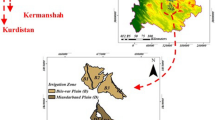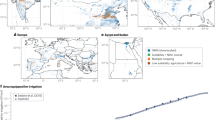Abstract
Irrigation is responsible for 80–90% of freshwater consumption in the USA. However, excess water demand, drought, declining groundwater levels, and water quality degradation all threaten future water supplies. In an effort to better understand how to efficiently use water resources, this analysis seeks to quantify the effect of soil water at various depths on the eventual crop yield at the end of a season as a lagged effect of space and time. As a novel modeling contribution, we propose a multiple spatiotemporal lagged model for crop yield to identify critical water times and patterns that can increase the crop yield per drop of water used. Because the crop yield data consist of nearly 20,000 observations, we propose the use of a nearest neighbor Gaussian process to facilitate computation. In applying the model to soil water and yield in Grace, Idaho, for the 2016 season, results indicate that soil moisture in the 0–0.3 m depth of soil was most correlated with crop yield earlier in the season (primarily during May and June), while the soil moisture at the 0.3–1.2 m depth was more correlated with crop yield later in the season around mid-June to mid-July. These results are specific to a crop of winter wheat under center-pivot irrigation, but the model could be used to understand relationships between water and yield for other crops and irrigation systems.
Supplementary materials accompanying this paper appear online.







Similar content being viewed by others
References
Allen, R. G., Pereira, L. S., Raes, D., Smith, M., et al. (1998), “Crop Evapotranspiration-Guidelines for Computing Crop Water Requirements-FAO Irrigation and Drainage Paper 56,” Fao, Rome, 300, D05109.
Banerjee, S. (2017), “High-dimensional Bayesian geostatistics,” Bayesian Analysis, 12, 583.
Cressie, N. and Johannesson, G. (2008), “Fixed rank kriging for very large spatial data sets,” Journal of the Royal Statistical Society: Series B (Statistical Methodology), 70, 209–226.
Cressie, N., and Wikle, C. K. (2015), “Statistics for Spatio-Temporal Data”, Wiley, New York.
Datta, A., Banerjee, S., Finley, A. O., and Gelfand, A. E. (2016), “Hierarchical nearest-neighbor Gaussian process models for large geostatistical datasets,” Journal of the American Statistical Association, 111, 800–812.
de Lara, A., Khosla, R., and Longchamps, L. (2017), “Characterizing spatial variability in soil water content for precision irrigation management,” Advances in Animal Biosciences, 8, 418–422.
Evans, R. G., LaRue, J., Stone, K. C., and King, B. A. (2013), “Adoption of site-specific variable rate sprinkler irrigation systems,” Irrigation Science, 31, 871–887.
Finley, A. O., Datta, A., Cook, B. C., Morton, D. C., Anderson, H. E., and Banerjee, S. (2017), “Efficient Algorithms for Bayesian Nearest Neighbor Gaussian Processes,” arXiv preprint arXiv:1702.00434.
Gelfand, A. E., Kim, H.-J., Sirmans, C., and Banerjee, S. (2003), “Spatial modeling with spatially varying coefficient processes,” Journal of the American Statistical Association, 98, 387–396.
Haghverdi, A., Leib, B. G., Washington-Allen, R. A., Ayers, P. D., and Buschermohle, M. J. (2015), “High-resolution prediction of soil available water content within the crop root zone,” Journal of Hydrology, 530, 167–179.
Heaton, M. J., Berrett, C., Pugh, S., Evans, A., and Sloan, C. (2018a), “Modeling bronchiolitis incidence proportions in the presence of spatio-temporal uncertainty,” Journal of the American Statistical Association, submitted.
Heaton, M. J., Datta, A., Finley, A. O., Furrer, R., Guinness, J., Guhaniyogi, R., Gerber, F., Gramacy, R. B., Hammerling, D., Katzfuss, M., et al. (2018b), “A case study competition among methods for analyzing large spatial data,” Journal of Agricultural, Biological and Environmental Statistics, 1–28.
Heaton, M. J. and Gelfand, A. E. (2011), “Spatial regression using kernel averaged predictors, ”Journal of Agricultural, Biological, and Environmental Statistics”, 16, 233–252.
— (2012), “Kernel averaged predictors for spatio-temporal regression models,” Spatial Statistics, 2, 15–32.
Hedley, C. B. and Yule, I. J. (2009), “Soil water status mapping and two variable-rate irrigation scenarios,” Precision Agriculture, 10, 342–355.
Jones, G. L., Haran, M., Caffo, B. S., and Neath, R. (2006), “Fixed-width output analysis for Markov chain Monte Carlo”, Journal of the American Statistical Association, 101, 1537–1547.
Kaufman, C. and Shaby, B. (2013), “The role of the range parameter for estimation and prediction in geostatistics,” Biometrika, 100, 473–484.
King, B. A., Stark, J., and Wall, R. W. (2006), “Comparison of site-specific and conventional uniform irrigation management for potatoes,” Applied Engineering in Agriculture, 22, 677–688.
Klute, A. (1986), “Water retention: laboratory methods,” Methods of Soil Analysis: Part 1 Physical and Mineralogical Methods, 635–662.
Lo, T. H., Heeren, D. M., Mateos, L., Luck, J. D., Martin, D. L., Miller, K. A., Barker, J. B., and Shaver, T. M. (2017), “Field characterization of field capacity and root zone available water capacity for variable rate irrigation,” Applied Engineering in Agriculture, 33, 559–572.
Martin, D., Stegman, E., and Fereres, E. (1990), “Irrigation Scheduling Principles,” in Management of Farm Irrigation Systems. American Society of Agricultural Engineers, St. Joseph, MI. 1990. pp. 155–203, 19 fig, 9 tab, 81 ref.
Messick, R. M., Heaton, M. J., and Hansen, N. (2017), “Multivariate spatial mapping of soil water holding capacity with spatially varying cross-correlations,” The Annals of Applied Statistics, 11, 69–92.
Postel, S. (1999), Pillar of Sand: Can the Irrigation Miracle Last?, WW Norton & Company, New York
Sadler, E., Evans, R., Stone, K., and Camp, C. (2005), “Opportunities for conservation with precision irrigation,” Journal of Soil and Water Conservation, 60, 371–378.
Ver Hoef, J. M., and Barry, R. P. (1998), “Constructing and fitting models for cokriging and multivariable spatial prediction,” Journal of Statistical Planning and Inference, 69, 275–294.
West, G. H., and Kovacs, K. (2017), “Addressing groundwater declines with precision agriculture: an economic comparison of monitoring methods for variable-rate irrigation,” Water, 9, 28.
Xu, K., Wikle, C. K., and Fox, N. I. (2005), “A kernel-based spatio-temporal dynamical model for nowcasting weather radar reflectivities,” Journal of the American statistical Association, 100, 1133–1144.
Zhang, H. (2004), “Inconsistent estimation and asymptotically equal interpolations in model-based geostatistics,” Journal of the American Statistical Association, 99, 250–261.
Funding
The project was supported by National Science Foundation (DMS-1417856).
Author information
Authors and Affiliations
Corresponding author
Additional information
Publisher's Note
Springer Nature remains neutral with regard to jurisdictional claims in published maps and institutional affiliations.
Electronic supplementary material
Below is the link to the electronic supplementary material.
Rights and permissions
About this article
Cite this article
Pugh, S., Heaton, M.J., Svedin, J. et al. Spatiotemporal Lagged Models for Variable Rate Irrigation in Agriculture. JABES 24, 634–650 (2019). https://doi.org/10.1007/s13253-019-00365-3
Received:
Accepted:
Published:
Issue Date:
DOI: https://doi.org/10.1007/s13253-019-00365-3




